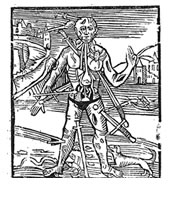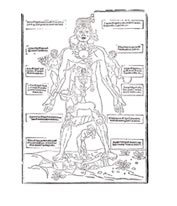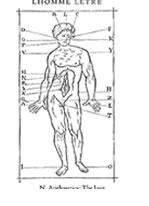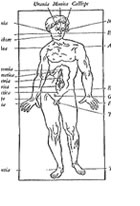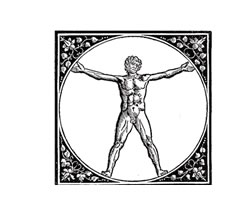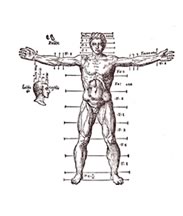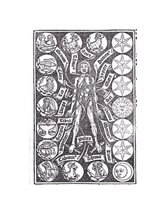|
 Johannes
Stoeffer, Calendrium Romanum...1518, Zodiacal Man Johannes
Stoeffer, Calendrium Romanum...1518, Zodiacal Man
 C.Estienne,
De Dissetione Partium, Paris 1575 Zodiacal Man C.Estienne,
De Dissetione Partium, Paris 1575 Zodiacal Man
 B
De Carpi, Tractatus Perultilis, Venice 1535, Head Injuries B
De Carpi, Tractatus Perultilis, Venice 1535, Head Injuries
 Albrecht
Durer, Della Simmetria, Venice 1585, childhood proportions Albrecht
Durer, Della Simmetria, Venice 1585, childhood proportions
This display records the use of the human body as a repository of
codes of information. Dedicated to Bruce Whatley are these exemplars
of symmetry with a rather camp contra posto added for good measure.
TOP ROW
01. from a rare work on Chirurgy (Surgery) perhaps
by Lanfrancus of Milan, and published in Augsberg by Froschauer in 1515.
The positioning of the Crab to the chest is not a diagnosis of Cancer,
but conforms to the symbolism of the melothesic figure.
02.from Ketham's Fasciculus Medicinae , Venice, 1493.
Each part of the body was influenced by a Zodiacal association, often
determining the times and nature of surgery. In a similar way the Melothesic
Figure is a Repository for the presences of the Zodiacal signs and symbols.
The Melothesic Figure
03/04 from Geoffrey Tory, Champ Fleury , first edition 1529, and a
masterpiece by a master printer of the French Renaissance. Tory sees
proportion, inner harmony and integrity in the design of letter forms
to be informed, even inspired, by the proportions and workings of the
human body. Here are two figures - L'HOMME LETRE and
L'HOMME SCIENTIFIQUE.
BOTTOM ROW
01. This image is reprinted from The Shepherd's Calendar,
published by Nicholas Le Rouge, Troyes, c1495. 5 x 14cms
02. VITRUVIAN MAN is in this tradition - a single nude male body incorporating
a proportional system attuned to a spiritual perfection. from the Venetian
edition of Vitruvius of 1511.
03. THE PROPORTIONS OF THE HUMAN MALE BODY FROM AN EARLY EDITION OF
VITRUVIUS (BOOKIII)
04. woodcut from the Sarum Liturgy , Paris 1510.
|





